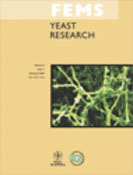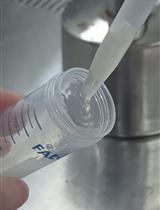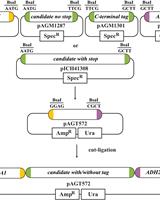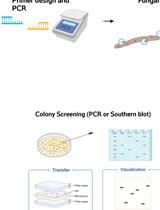- EN - English
- CN - 中文
Development of an Efficient Transformation System for Halotolerant Yeast Debaryomyces hansenii CBS767
耐盐汉斯德巴氏酵母菌CBS767的一种高效转化体系的建立
(*contributed equally to this work) 发布: 2019年09月05日第9卷第17期 DOI: 10.21769/BioProtoc.3352 浏览次数: 4109
评审: Gal HaimovichEmilia KrypotouAnonymous reviewer(s)
Abstract
Debaryomyces hansenii is one of the most osmotolerant and halotolerant yeasts. Further, its association with traditional cheese and meat products imparting special flavors to these products project this yeast with enormous biotechnological potential in the agrofood sector. However, lack of an efficient transformation system in D. hansenii still direct the complementation based assay in S. cerevisiae mutants for functional analysis of D. hansenii genes. Here, we have described the development of an efficient transformation system for D. hansenii that is based on a histidine auxotrophic recipient strain, DBH9 (generated by UV induced random mutagenesis), and the DhHIS4 gene as the selectable marker (Minhas et al., 2009). Moreover, the same method has also been employed for gene disruption in D. hansenii by homologous recombination.
Keywords: Debaryomyces hansenii (汉斯德巴氏酵母菌)Background
Debaryomyces hansenii CBS767 is one of the most osmotolerant and halotolerant yeasts and can tolerate salinity levels up to 4 M NaCl, whereas growth of Saccharomyces cerevisiae is inhibited when salinity reaches above 1.7 M NaCl. Debaryomyces hansenii is frequently associated with traditional cheese and meat products imparting special flavors to these products. Therefore, this yeast is not only an excellent model to study salt tolerance mechanisms in eukaryotic cells but it also has enormous biotechnological potential in the agrofood sector. However, lack of efficient transformation system and gene disruption tools required for gene manipulation in D. hansenii is a big lacuna behind the molecular analysis of its halotolerant feature. Ricaurte and Govind (1999) developed an ura3 mutant based transformation system for D. hansenii; however this system exhibited low-efficiency. Despite the development of transformation system for Candida famata (Voronovsky et al., 2002), an anamorph of D. hansenii, functional studies of the genes from D. hansenii are still based on complementation of S. cerevisiae mutants. Our transformation system is based on a histidine auxotrophic strain, DBH9 and the DhHIS4 gene as the selectable marker. The same method has also been demonstrated for gene disruption in D. hansenii by homologous recombination (Minhas et al., 2009).
Materials and Reagents
- Pipettes (Thermo Fisher Scientific, catalog numbers: 4652080, 4652050, 4652020, 4652010)
- Flask (Borosil, catalog numbers: 4980009, 4980012, 4980016, 4980021)
- Graduated cylinder (Borosil, catalog number: 3021029)
- Centrifuge tube (Oak Ridge,catalog number: 541040)
- Safe-Lock tubes 2.0 ml (Eppendorf, catalog number: 0030120094)
- Disposable Petri plates (Tarson, catalog number: 460090)
- Pipette tips (Tarson, catalog numbers: 521000, 521010, 521020)
- 0.2 µm syringe filter (Millipore, catalog number: SLGP033RS)
- 0.2 cm Electroporation cuvette (BioRad, catalog number: 1652086)
- DBH9: D. hansenii strain CBS767 (MTCC 3461) ∆dhhis4 (Original manuscript, Minhas et al., 2009)
- Plasmid pDH4 (for cloning details refers to materials and methods section in Minhas et al., 2009)
- Sodium phosphate, dibasic (Merck, catalog number: 567550)
- Sodium phosphate, monobasic (Merck, catalog number: 567549)
- DL-Dithiothreitol (DL- DTT) (Sigma, catalog number: 43815)
- Glycerol (Sigma-Aldrich, catalog number:G9012)
- Sucrose (Sigma, catalog number: S8501)
- Glucose (Himedia, catalog number: MB037)
- Agar (Himedia, catalog number: GRM026)
- YPD broth (BD Difco, catalog number: DF0428-17-5)
- Yeast minimal media-SD base (Clontech, catalog number: 630411)
- Sterile water (Lab Pure-Series Model-Analytic UV)
- YPD broth medium (see Recipes)
- SD minimal agar medium with 0.3 M sucrose (see Recipes)
- YPD agar medium (see Recipes)
- 1 M sodium phosphate buffer, pH 7.5 (see Recipes)
- 1 M D L- DTT (see Recipes)
- 1 M Sucrose (see Recipes)
Equipment
- Incubator, New BrunswickTM Innova® 44 (Eppendorf, model: M1282-0002)
- UV-VIS spectrophotometer (Shimadzu, model: UV 1900)
- Microcentrifuge (Eppendorf, model: 5415R)
- Centrifuge (REMI, model: CPR-24Plus)
- Water bath (Julabo, model: PURA 4)
- Gene Pulser (BioRad, model: GenePulserXcell)
- Vortex (DLAB, model: MX-S)
- Laminar air flow (Ocean life science corp, model: OLSC 113-4)
- L- spreader (Himedia, model: PW1085)
- Autoclave
Software
- TBLASTN search tool on NCBI website (https://blast.ncbi.nlm.nih.gov/Blast.cgi?PROGRAM=tblastn&PAGE_TYPE=BlastSearch&LINK_LOC=blasthome)
Procedure
文章信息
版权信息
© 2019 The Authors; exclusive licensee Bio-protocol LLC.
如何引用
MINHAS, A. P. and Biswas, D. (2019). Development of an Efficient Transformation System for Halotolerant Yeast Debaryomyces hansenii CBS767. Bio-protocol 9(17): e3352. DOI: 10.21769/BioProtoc.3352.
分类
微生物学 > 微生物遗传学 > 转化
分子生物学 > DNA > 转化
您对这篇实验方法有问题吗?
在此处发布您的问题,我们将邀请本文作者来回答。同时,我们会将您的问题发布到Bio-protocol Exchange,以便寻求社区成员的帮助。
提问指南
+ 问题描述
写下详细的问题描述,包括所有有助于他人回答您问题的信息(例如实验过程、条件和相关图像等)。
Share
Bluesky
X
Copy link













